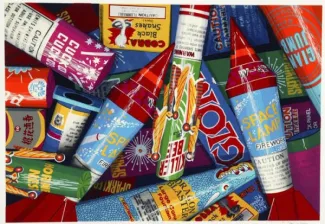
Art for Art’s Sake
I purchased my first piece of real art (i.e., not an art poster from a shop in the West Village) as a housewarming and anniversary present for my husband years ago. It is a silkscreen print of firecrackers from a local artist (Clay Huffman, now deceased) who had a studio at the Torpedo Factory Art Center in Old Town, Alexandria. My husband liked the content and composition and the fact that it was bold, bright, and colorful. I thought it was a fun choice to start decorating our new shared space. We have been consumers of art ever since and have run out of wall space to hang everything we’ve acquired.
Artwork evokes a specific reaction and remembrance of when and why we chose to buy it. My husband likes to buy art when we (infrequently) travel, because that’s what his parents did and then we have a visual to the story of those adventures. We purchase art that speaks to us, because, as an investment, art has its limitations. First, and foremost, is the start-up cost of building an art collection with any real value. Only consumers with an ultra-high net worth need apply. A good art investment is one that you could potentially resell for a higher amount than what you paid. And that, my friends, is a rare find.
Having said that, the Sotheby’s Mei Moses Index for the broad art market shows a compound annual growth rate of 8.5% from 1950 through 2021. How the index is calculated hints at some of the bias in the art world. “Sotheby’s Mei Moses uses the purchase prices of the same painting at two distinct moments in time (i.e., repeat-sales) to measure the change in the value of unique works of art.” While the index tracks 60,000 repeat sales from 1810, it is also true that, “Just 1 percent of all artists generate more than half of all artworks sold globally.” So, it seems like a small pool that big fish are thrashing around in and exchanging wealth in the process.
Does any of the art that we own have value, aside from its intrinsic qualities that inspire and create joy? Probably not. But every once in a while, I do a quick Google search on a few of our pieces to see if they are worth more than what I paid for them, just to be sure. Turns out, we may have made a small profit on one print, after all. Not that we are interested in selling.
Read the West Financial Services blog. »
Sources:
https://www.sothebys.com/smm
https://www.rbcwealthmanagement.com/en-us/insights/is-artwork-a-wise-investment
IMPORTANT DISCLOSURES
West Financial Services, Inc. (“WFS”) offers investment advisory services and is registered with the U.S. Securities and Exchange Commission (“SEC”). SEC registration does not constitute an endorsement of the firm by the SEC nor does it indicate that the firm has attained a particular level of skill or ability. You should carefully read and review all information provided by WFS, including Form ADV Part 1A, Part 2A brochure and all supplements, and Form CRS.
Certain information contained herein was derived from third party sources, as indicated, and has not been independently verified. While the information presented herein is believed to be reliable, no representation or warranty is made concerning the accuracy of any information presented. Where such sources include opinions and projections, such opinions and projections should be ascribed only to the applicable third party source and not to WFS
This information is intended to be educational in nature, and not as a recommendation of any particular strategy, approach, product, security, or concept. These materials are not intended as any form of substitute for individualized investment advice. The discussion is general in nature, and therefore not intended to recommend or endorse any asset class, security, or technical aspect of any security for the purpose of allowing a reader to use the approach on their own. You should not treat these materials as advice in relation to legal, taxation, or investment matters. Before participating in any investment program or making any investment, clients as well as all other readers are encouraged to consult with their own professional advisers, including investment advisers and tax advisers.

